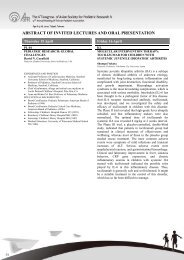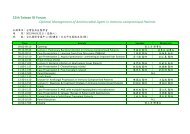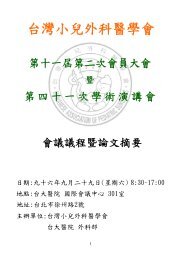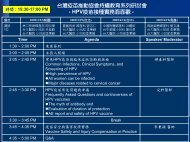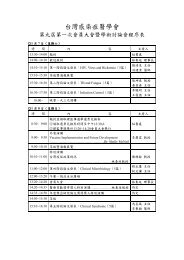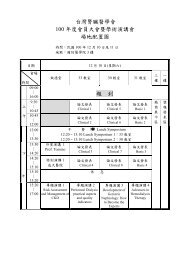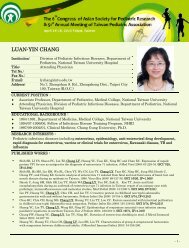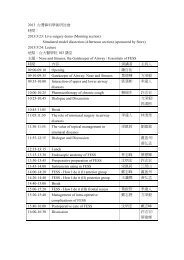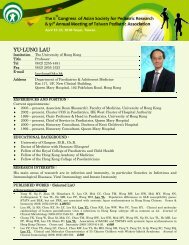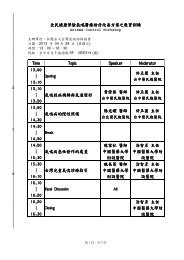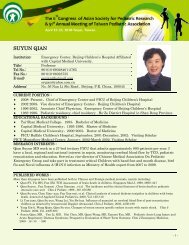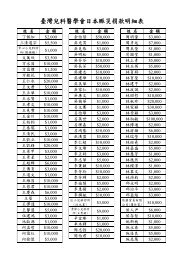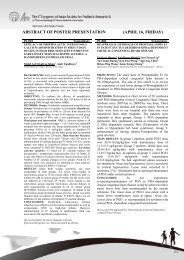ABSTRACT OF POSTER PRESENTATION (APRIL 17, SATURDAY)
ABSTRACT OF POSTER PRESENTATION (APRIL 17, SATURDAY)
ABSTRACT OF POSTER PRESENTATION (APRIL 17, SATURDAY)
You also want an ePaper? Increase the reach of your titles
YUMPU automatically turns print PDFs into web optimized ePapers that Google loves.
P2-031 Allergy/Immunology/Rheumatology P2-032 Allergy/Immunology/RheumatologyASSOCIATION STUDY BETWEEN B- ANDT-LYMPHOCYTE ATTENUATOR GENE ANDTYPE 1 DIABETES MELLITUS ORSYSTEMIC LUPUS ERYTHEMATOSUS INTHE DIFFERENT <strong>PRESENTATION</strong>S <strong>OF</strong> ASTHMAAND ASTHMA-LIKE SYMPTOMS BETWEENFOREIGN AND NATIVE MOTEHR AMONGPRESCHOOL CHILDREN IN TAIWANTHE JAPANESE POPULATION1 Mika Makimura, 1 Kenji Ihara, 1 Terumichi Matsuo,2 Hitoshi Kohno, 1 Toshiro Hara1) Department of Pediatrics, Graduate School of Medical Sciences, KyushuUniversity,; 2) Department of Endocrinology and Metabolism, FukuokaChildren’s Hospital and Medical Center for Infectious Diseases, JapanKuo-Wei Yeh 1,2 , Shun-An Wu 1 , Liang-Shiou Ou 1,2 ,Jing-Long Huang 1,21.Department of Pediatrics, Chang Gung Children’s Hospital, Taoyuan,Taiwan; 2.Community Medicine Research Center, Chang Gung Memorialhospital at Keelung, Keelung, TaiwanBACKGROUND & AIMS: B- and T-lymphocyteattenuator (BTLA) is a member of co-inhibitoryreceptor in the CD28 family and functions as anegative regulation of T cell activation. BTLA alsointeracts with herpesvirus-entry mediator whichbelongs to a tumor-necrosis factor receptorsuperfamily, suggesting a unique crosstalk betweenthese superfamilies. Our study is to elucidatewhether the BTLA gene is a new susceptibility genein the CD28 family for the development of T1Dand/or SLE in the Japanese population.METHODS: We selected three polymorphic sites inthe BTLA gene, and then alleles, genotypes orestimated haplotype frequencies of these sites werecompared between T1D or SLE patients andcontrols.RESULTS: None of them showed any significantdifference.CONCLUSIONS: The contribution of the BTLAgene to development of T1D and SLE in Japanesepopulation was not shown, therefore, furtherevaluation in other ethnic groups with larger studypopulation for other autoimmune diseases may showsome different results, and disclose the genetic rolesof the BTLA gene. (164 wards)[Keywords]BTLA; T1D; SLE; autoimmune diseasePURPOSE: The traditional asthma prevalence survey wasbased on International Study of Asthma and Allergies inChildhood (ISAAC) questionnaire which focused on age of 6-7and 13-14. However, asthma-like symptoms usuallycommenced in preschool children, and it was hard to makedefinite diagnosis of asthma among them. To marry newimmigrants increased in recent years in Taiwan. It was reportedthat one out of eight newborns was born by foreign mothers. Itis worth to determine the prevalence rate of asthma orasthma-like symptoms and analyze the different presentationsamong preschool children with native or foreign mothers.MATERIAL AND METHOD: Children aged 3–6 years wererecruited through the kindergartens for this survey in Keelungcity, Taiwan. The questionnaire used was based on the ISAACphase III core and environmental questionnaires and includedquestions on asthma, rhinoconjunctivitis, and eczema, alongwith questions to elicit common and early presentations ofasthma, as well as other demographic and environmental data.The questionnaires delivered and completed by parents.RESULTS: There were 2395 questionnaires delivered toparents with children in 50 kindergartens. There were 2<strong>17</strong>0questionnaires returned and the return rate was 90.6% and80.3% of returned questionnaires were completed by nativemothers. It was 9.9% of the preschool children withphysician-diagnosed asthma generally. However, it was 20.4%of them experienced asthma-like symptoms in kindergarten. Itwas 10.1% of children with native mothers hadphysician-diagnosed asthma and 9.6% of children with foreignmothers. Both group had no significant difference (p=0.765).However, as for presentations of wheeze ever, it was 18.2% inchildren with native mothers, and 11.3% of foreign mothersrespectively (p=0.001). Children with native mothers also hadexperienced cough more than 3 weeks more frequently(21.0%) comparing children with foreign mothers (12.0%,p



